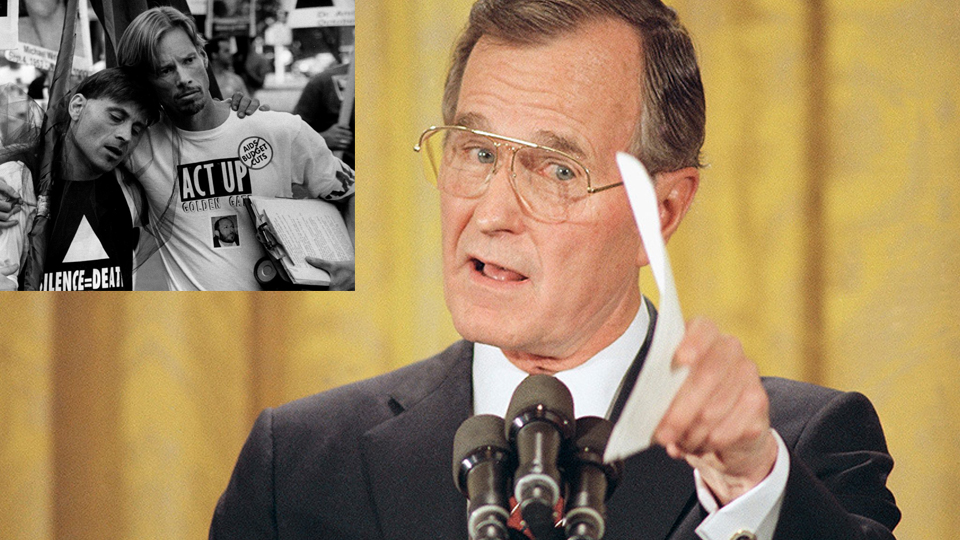
The 41st President of the United States, George H.W. Bush, has died at a moment in our history when we are literally starved for some displays of decency in our national leadership. This is to be expected under a President Trump who tells us it’s fine to jump into bed with an autocratic king because he buys weapons from us or who tells us tear gassing of children is ok because it deters immigration.
The abundance of crass cruelty and total absence of civility in the White House makes us seek out any bit of civility, no matter how small, that we can find in our national leadership. Such is the case with George H.W. Bush who is being held up as an example of someone who was so much better than Trump.
As understandable as this is, however, we should not forget that Trumpism did not just pop into existence. Trump and everything that comes with him, including his strong fascist streak, is the end product of a process long developed and carried out by the Republican Party, including the party of George H.W. Bush. The continuing AIDS crisis today provides a clear example of how poorly the AIDS epidemic was handled by George H.W. Bush when it first began to ravage the nation.
George H.W. passed on World AIDS Day, and perhaps it is irony, or serendipity, that we can use this coincidence to bring to light Bush’s problematic past with AIDS prevention, while looking to the future of activism to ensure defeat of a disease that continues to plague not only the LGBTQ community, but communities of color, women, and the poor at excessive rates.
HIV-related mortality rates rose steadily in the 1980s, and although there has been a significant decline, the number of people affected by HIV/AIDS is still high. In the United States alone, there are more than one million people living with HIV today. There have been more than 700,000 people with AIDS who have died since the first reported U.S. cases of the disease in 1981. Former President George H.W. Bush was in two of the highest government offices during the peak of the AIDS epidemic, and his policies and biases harmed the effort to deal with the health crisis.
Bush, as vice president to former President Ronald Reagan, was part of an administration that refused to speak publicly about HIV/AIDS for several years. When news about the disease began to spread, it was closely associated with gay men, and therefore deemed the “gay plague” by the media. The 2015 documentary by Scott Calonico, When AIDS Was Funny, unearthed press conference recordings of Reagan’s press secretary Larry Speakes, addressing the AIDS crisis jokingly. Reagan refused to mention the disease publicly until 1985, when more than 5,000 people in the U.S. had already died from complications with AIDS. By the end of that year, every region in the world had reported at least one case of AIDS, with 20,303 cases in total.
When Bush succeeded Reagan as president some may argue his action on HIV/AIDS was better than that of his predecessor, while others will note that it took the activism of organizations pushing the Bush administration to act that made any movement possible. Although Bush often took note during his presidency of the work his administration was doing on the epidemic, according to the National Center for Health Statistics, in 1989, the first year of the Bush administration, there were 21,628 AIDS-related deaths in the United States. This number would actually rise to 24,524 in 1990, 28,569 in 1991 and 32,407 in 1992. Bush considered the health crisis to be “behavioral,” thus perpetuating the stigma of the disease as related to only gay men and the stereotype of unsafe sex practices.
During a 1992 presidential debate with opponent Bill Clinton, Bush, when asked about the HIV/AIDS crisis, stated, “It’s one of the few diseases where behavior matters. And I once called on somebody, ‘Well, change your behavior! If the behavior you’re using is prone to cause AIDS, change the behavior!’”
It was during this time that organizations, such as the AIDS Coalition to Unleash Power (ACT UP), were continuing their crusade to bring about legislation, policies, medical research and treatment to bring an end to the disease. ACT UP held a now-famous direct action demonstration called the “ashes action” in 1991, where participants, holding signs demanding a national plan, placed the ashes of their dead loved ones who died of complications with AIDS on the White House steps.
It was this public pressure by activists that was crucial to pressuring Bush to sign the Ryan White CARE Act. This act provided health coverage for low-income people with HIV/AIDS. He also signed into law an Americans with Disabilities Act that barred discrimination against people with HIV/AIDS. Over 100,000 people in the United States died from the disease during Bush’s presidency, and many continue to die or go undiagnosed, now. This disease, then and also today, goes beyond the LGBTQ community.
HIV is a youth issue, as the millennial generation, which comprises more than half of the current working class, is greatly affected by HIV/AIDS. In 2015, HIV was the ninth leading cause of death for those aged 25-44. HIV is a racial issue, as communities of color are disproportionately affected by the disease. Black Americans, who are just 14 percent of the U.S. population, accounted for 44 percent of deaths among people with an HIV diagnosis in 2015. HIV is a women’s issue, with more than 256,500 women living with HIV in the U.S. HIV is a Black women, and women of color, issue. Seventy two percent of women diagnosed with HIV were Black, according to a report issued in 2016.
Strives have been made to overcome the lack of treatment and diagnosis, but more can be done to deal with the continued stigma against those with HIV, and access to preventative medicine. Education and access to Pre-Exposure Prophylaxis (PrEP) can help prevent HIV infection in people who don’t have HIV, but who are at high risk of becoming infected.
World AIDS Day, established in 1988, helps to bring about awareness to a prevalent issue, that needs to be addressed all year round. AIDS affects groups of people who are often marginalized and exploited by a system that uses their labor but cares little for their health and well-being. This system was in place before Bush, during his presidency, and continues after. As we look back on the former president’s life, there will be those who will mourn the loss of one man, but it seems more fitting to mourn the loss of thousands to an epidemic forever tied to his legacy, and to continue the fight to make sure we don’t continue to lose thousands more.












Comments